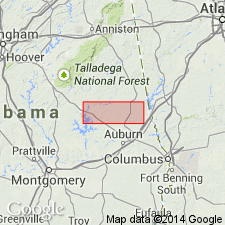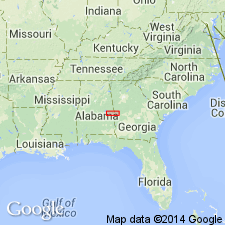
- Usage in publication:
-
- Chattasofka Creek Gneiss
- Modifications:
-
- Named
- Dominant lithology:
-
- Gneiss
- AAPG geologic province:
-
- Piedmont-Blue Ridge province
Summary:
Felsic rocks of the Dadeville Complex in the study area previously assigned to the Camp Hill granite by Bentley and Neathery (1970) and to the Camp Hill Granite Gneiss by Raymond and others (1988) are here subdivided into the Camp Hill Gneiss (redefined) and the newly named Chattasofka Creek Gneiss. Type locality is designated in Tallapoosa Co., just east of Dadeville where unit is medium-grained with a foliation defined by dimensionally aligned biotite. Unit is more leucocratic than the Camp Hill and contains far more alkali feldspar. Biotite and muscovite are abundant. Unit has not been isotopically dated but is younger than both the Agricola Schist and the Ropes Creek Amphibolite for it contains xenoliths of these units. Plutonism may represent the onset of the Acadian Orogeny. Probably equivalent to the Farmville Metagranite of the Opelika Complex, which is considered Late Devonian.
Source: GNU records (USGS DDS-6; Reston GNULEX).

- Usage in publication:
-
- Chattasofka Creek Gneiss*
- Modifications:
-
- Overview
- AAPG geologic province:
-
- Piedmont-Blue Ridge province
Summary:
Inner Piedmont is divided into two groups of rocks, Dadeville and Opelika Complexes (Bentley and Neathery, 1970), divided by Stonewall line. Dadeville Complex consists of Agricola Schist, Waresville Schist, Camp Hill Gneiss, Chattasofka Creek Gneiss, Ropes Creek Amphibolite, Waverly Gneiss, Simmons Crossroads metagranite (informal), and various unnamed mafic and ultramafic intrusive rocks. Opelika Complex consists of Loachapoka Schist, Saugahatchee quartzite, and Auburn Gneiss and schist. Farmville Metagranite intrudes these units. Age of all Inner Piedmont rocks is early Paleozoic. Report includes geologic sketch map.
[Remark reflects usage as published, not as reviewed in draft form. Although GNU review requested informal terms to be inverted, the published version shows that authors did not comply with request. Whatley Mill is misspelled as Whatley Mills in published version; error introduced after GNU review (GNU records, USGS DDS-6; Reston GNULEX 01/21/94).]
Source: GNU records (USGS DDS-6; Reston GNULEX).
For more information, please contact Nancy Stamm, Geologic Names Committee Secretary.
Asterisk (*) indicates published by U.S. Geological Survey authors.
"No current usage" (†) implies that a name has been abandoned or has fallen into disuse. Former usage and, if known, replacement name given in parentheses ( ).
Slash (/) indicates name conflicts with nomenclatural guidelines (CSN, 1933; ACSN, 1961, 1970; NACSN, 1983, 2005, 2021). May be explained within brackets ([ ]).

